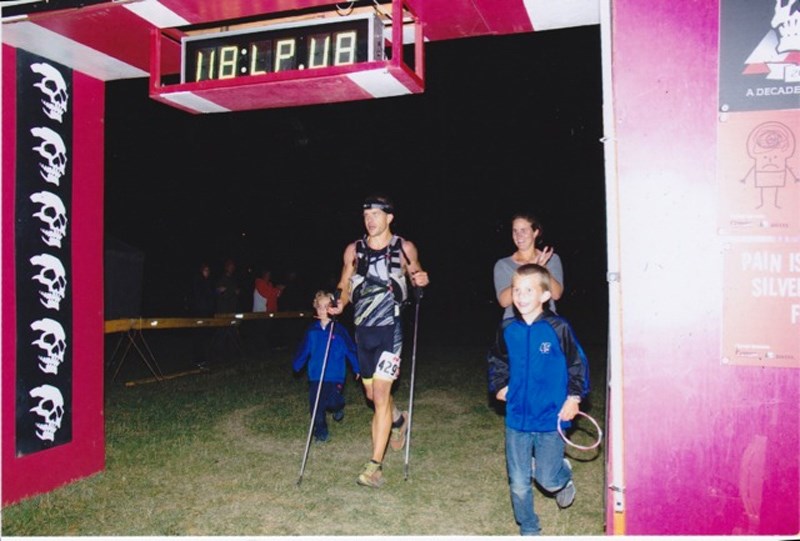Barrhead resident Murray Tuininga competed in the annual Death Race in Grande Cache, Alberta on Saturday, August 2.
The Canadian Death Race is a 125-kilometre foot race through the Canadian Rocky Mountains in Grande Cache. It includes three mountain summits, one major river crossing, and 17,000 feet of elevation change. The race has been held annually on the August long weekend since the year 2000.
This was the second time Tuininga competed in the race but the first time he ran all five legs as a solo competitor. He competed as part of a team last year.
“I just got into running last year so it was new terrain for me. I was used to pavement running so I had never run a hill before. Last year, was a really big learning curve. I ran leg two of the race and I did well, which is one of the harder legs of the race,” said Tuininga. “Last year, after completing my leg of the race, I vowed I would never do it again and I would never do the whole thing solo, it was just insane but pain is something we can’t remember so I saw running it solo as a challenge.”
Tuininga finished the race in 16:07:11, finishing second in the 30-39 age group and eighth overall.
“There were 366 total competitors but only 114 solo competitors finished the race. It was one of their highest dropout rates but they were expecting that to happen because they called this the hottest race in the last 15 years for sustained heat,” added Tuininga.
Tuininga went on to discuss his strong time and finish in the race.
“I originally thought it would be neat to place in the age group and place in the top ten overall. I thought this year was a learning curve so I was hoping to accomplish those goals. The neat part was I accomplished them all,” he added.
Tuininga described the most difficult aspect of competing in this year’s Death Race.
“The most difficult thing was the heat. I think most runners would rather run in rain or mist versus extreme heat. You can dress for cold weather you can’t undress for heat,” he said.
The Death Race is broken up into five legs and solo runners run all of the legs while, if you were part of a team, each runner ran their own leg. Tuininga discussed which leg was the most difficult.
“Leg five was the most difficult because of the exhaustion at that point. I had run them all at a training camp over 48 hours but I had two sleeps in there so I though leg five was easy. At that point in the race, I couldn’t take on any more nutrition. I wasn’t eating anything for the last four hours of the race,” he said. “The last two hours was interesting because I had the will to run knowing it would be over soon instead of getting a faster time. I figured I could lay down quicker if I finished the race quicker.”
Tuininga also described the physical toll on his body after completing the race.
“Gastro-intestinally it took about a day to get back to normal and start eating normally again. As far as physical pain, blisters were my biggest thing. I had a couple-inch blisters on the forefront of the bottom of each foot. It took a few weeks to recover from my physical injuries stemming from the race,” he said. “Physically, during the race, the body always wants to shut down sooner than it needs to so it is the mental challenge that is most difficult but I had the mental strength to finish race.”
Tuininga said he was ecstatic that he finished the race and explained what it was like to cross the finish line.
“You have this sense of emotion like jubilation but it quickly turned into exhaustion. I have never been that physically exhausted in my life as I was at the end of that race,” Tuininga said. “That was quite a reward for the time spent training and everything that led up to the race. It was a great experience and I want to do it again. I would run the Death Race again. Absolutely.”
Tuininga described where completing the Death Race ranks for himself on a personal level.
“Completing the Death Race is a different kind of moment so I can’t compare it to getting married or having kids. It is something different and more a sense of personal accomplishment. It is a bucket-list item for sure,” he said. “The other sense of accomplishment was that only 24 teams beat my time. There were 280 teams that competed and only 24 of those teams finished ahead of me. Staying ahead of that many teams was really the biggest sense of accomplishment.”
Tuininga is now looking forward to next year, where he may run the Death Race again and already has personal goals in mind.
“I will run a Death Race again but the next time I will aim for 15 hours. I think that would be a realistic goal. I completed it and I survived it this year but even though I finished the race, I still have unfinished business because I can always improve my time and finish,” concluded Tuininga.



